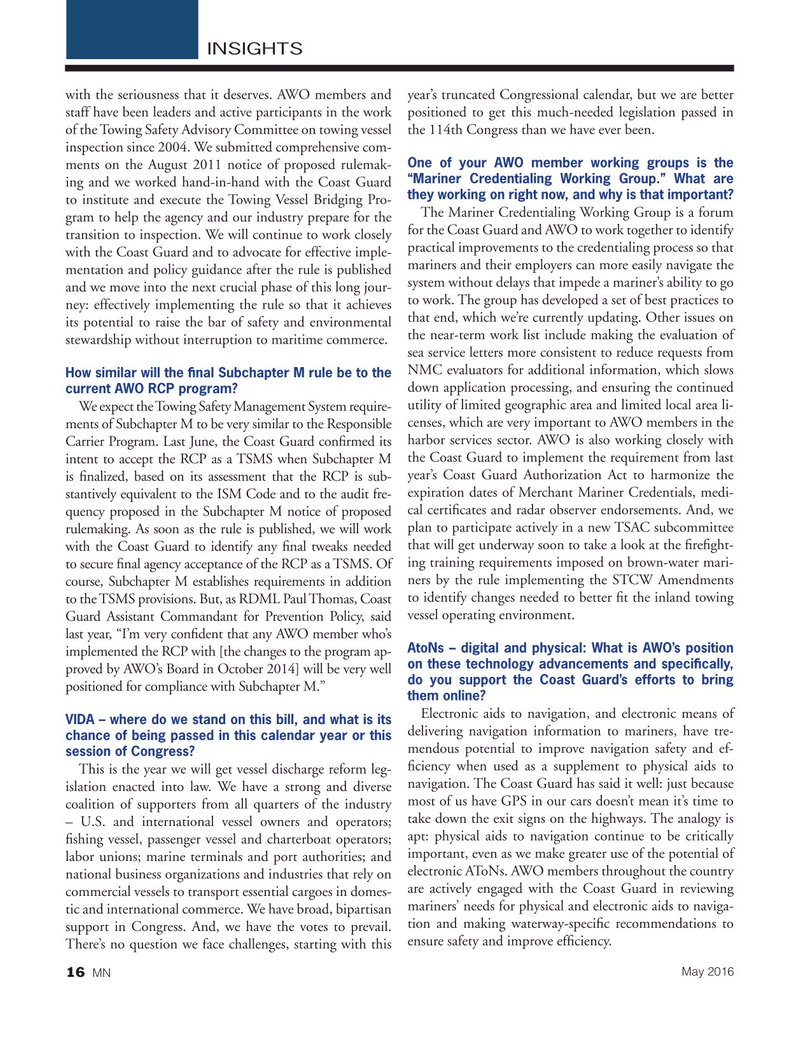
Page 16: of Marine News Magazine (May 2016)
Inland Waterways
Read this page in Pdf, Flash or Html5 edition of May 2016 Marine News Magazine
INSIGHTS with the seriousness that it deserves. AWO members and year’s truncated Congressional calendar, but we are better staff have been leaders and active participants in the work positioned to get this much-needed legislation passed in of the Towing Safety Advisory Committee on towing vessel the 114th Congress than we have ever been. inspection since 2004. We submitted comprehensive com-
One of your AWO member working groups is the ments on the August 2011 notice of proposed rulemak- “Mariner Credentialing Working Group.” What are ing and we worked hand-in-hand with the Coast Guard they working on right now, and why is that important? to institute and execute the Towing Vessel Bridging Pro-
The Mariner Credentialing Working Group is a forum gram to help the agency and our industry prepare for the transition to inspection. We will continue to work closely for the Coast Guard and AWO to work together to identify practical improvements to the credentialing process so that with the Coast Guard and to advocate for effective imple- mentation and policy guidance after the rule is published mariners and their employers can more easily navigate the system without delays that impede a mariner’s ability to go and we move into the next crucial phase of this long jour- ney: effectively implementing the rule so that it achieves to work. The group has developed a set of best practices to its potential to raise the bar of safety and environmental that end, which we’re currently updating. Other issues on the near-term work list include making the evaluation of stewardship without interruption to maritime commerce.
sea service letters more consistent to reduce requests from
NMC evaluators for additional information, which slows
How similar will the ? nal Subchapter M rule be to the down application processing, and ensuring the continued current AWO RCP program?
utility of limited geographic area and limited local area li-
We expect the Towing Safety Management System require- ments of Subchapter M to be very similar to the Responsible censes, which are very important to AWO members in the
Carrier Program. Last June, the Coast Guard con? rmed its harbor services sector. AWO is also working closely with intent to accept the RCP as a TSMS when Subchapter M the Coast Guard to implement the requirement from last year’s Coast Guard Authorization Act to harmonize the is ? nalized, based on its assessment that the RCP is sub- expiration dates of Merchant Mariner Credentials, medi- stantively equivalent to the ISM Code and to the audit fre- quency proposed in the Subchapter M notice of proposed cal certi? cates and radar observer endorsements. And, we rulemaking. As soon as the rule is published, we will work plan to participate actively in a new TSAC subcommittee with the Coast Guard to identify any ? nal tweaks needed that will get underway soon to take a look at the ? re? ght- to secure ? nal agency acceptance of the RCP as a TSMS. Of ing training requirements imposed on brown-water mari- course, Subchapter M establishes requirements in addition ners by the rule implementing the STCW Amendments to the TSMS provisions. But, as RDML Paul Thomas, Coast to identify changes needed to better ? t the inland towing
Guard Assistant Commandant for Prevention Policy, said vessel operating environment.
last year, “I’m very con? dent that any AWO member who’s
AtoNs – digital and physical: What is AWO’s position implemented the RCP with [the changes to the program ap- on these technology advancements and speci? cally, proved by AWO’s Board in October 2014] will be very well do you support the Coast Guard’s efforts to bring positioned for compliance with Subchapter M.” them online?
Electronic aids to navigation, and electronic means of
VIDA – where do we stand on this bill, and what is its delivering navigation information to mariners, have tre- chance of being passed in this calendar year or this mendous potential to improve navigation safety and ef- session of Congress?
? ciency when used as a supplement to physical aids to
This is the year we will get vessel discharge reform leg- islation enacted into law. We have a strong and diverse navigation. The Coast Guard has said it well: just because coalition of supporters from all quarters of the industry most of us have GPS in our cars doesn’t mean it’s time to – U.S. and international vessel owners and operators; take down the exit signs on the highways. The analogy is ? shing vessel, passenger vessel and charterboat operators; apt: physical aids to navigation continue to be critically labor unions; marine terminals and port authorities; and important, even as we make greater use of the potential of national business organizations and industries that rely on electronic AToNs. AWO members throughout the country are actively engaged with the Coast Guard in reviewing commercial vessels to transport essential cargoes in domes- tic and international commerce. We have broad, bipartisan mariners’ needs for physical and electronic aids to naviga- support in Congress. And, we have the votes to prevail. tion and making waterway-speci? c recommendations to
There’s no question we face challenges, starting with this ensure safety and improve ef? ciency.
May 2016
MN 16
MN May16 Layout 1-17.indd 16 MN May16 Layout 1-17.indd 16 4/20/2016 3:37:08 PM4/20/2016 3:37:08 PM

 15
15

 17
17
